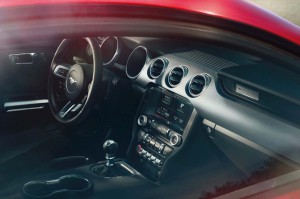“When you’re redoing an icon,” says Ford’s new CEO Mark Fields, you find yourself gripped by “a combination of a great honor and a great fear.” Just ask Dave Pericak, who was given the daunting job of redesigning one of those icons as the chief engineer for the 2015 Ford Mustang program.
It wasn’t just a new version of the classic pony car Pericak had to shepherd into production, but the creation of a vehicle worthy of being the 50th anniversary Mustang. It had to be, as he is fond of saying, “the best Mustang ever.” No idle boast, but, after spending a few days watching a procession of automotive journalists get their first rides in the pony car, Pericak looked more than a bit relieved. As well he should.
There are a few nits to pick, but they’re largely cosmetic, a few places Ford might have stretched a little further. But there’s little doubt that the coupe and convertible muscle cars Ford will be shipping to dealers around the world in the months ahead can far and away lay claim to being the best Mustang ever.
Better yet, the new design, the new platform and suspension, the expanded range of powertrains, all suggest that the new 2015 Mustang will lead to even better things to come as the car goes through its lifecycle.
(Mustangs to come likely to adopt more advanced powertrain technology. Click Here to learn what could be in the works.)
As with other automotive icons, such as the Porsche 911, the Mustang team had to strike a delicate balance. They needed to respect history and tradition, but without being trapped by the past. That’s readily apparent in the new car’s design. You know at first glance that this is a Mustang, but it’s not another retro-styled throwback, like the model we got eight years go.
The 2015 coupe is surprisingly elegant, rather than brutish; it features sensually sculpted body panels accented by angular creases. Chris Svensson, head of the design team, likes to say it is “much more sculptural and three-dimensional than before.”
The updated, “sharkbite” grille has generated a bit of controversy, adopting a shape more in line with other Ford models, such as the Focus, but the new Mustang doesn’t abandon its classic muscularity. If anything, the longer slope to its hatchback, the wider rear end and the way the greenhouse tucks in as it flows rearward, give the appearance of still more power.
Svensson notes that the design team wanted to enhance the new Mustang’s appeal to women without turning off potential male buyers. They also had to give the car a more worldly look — as it will go on sale abroad for the first time – while still looking like a classic piece of American iron. To our eyes, the new design succeeds admirably.
(Overseas markets “clamoring” for new 50th anniversary Mustang. Click Here for the full story.)
Of course, a pony car’s beauty has to be much more than skin deep. The good news is that Pericak’s team gave Ford designers a solid platform to sculpt around. The original goal for the program was actually to migrate from Mustang’s old chassis to an entirely new “architecture” it would share with other worldwide products – in keeping with the One Ford global strategy. Ultimately, common sense prevailed, and the 2015 Mustang got what it needed.
That meant not only a new platform but an all-new suspension system, front and back. The revised front double-ball joint layout allowed Ford to package in much-needed larger brakes. The all-new independent rear suspension – a first for a non-special edition Mustang – is the transformative element.
You notice a difference even while negotiating heavy traffic through trendy Hollywood, but the payoff was fully apparent as we headed up toward the open roads carved through the Angeles National Forest. With the old Mustang, you’d have cherished every little straight stretch of tarmac, putting the car’s classic 5.0-liter V-8 to work, then hitting the brakes and sawing your way through the twisties. Not this time.
We found ourselves relishing every little turn, steadily building speed as our confidence grew. The 5.0-liter version of the new Mustang is, as you might expect, a bit nose-heavy, with a 55/45 front-to-back weight balance. But understeer was surprisingly minimal. We found the car carving around corners with a level of aplomb you might expect from a European sports car, not a class muscle car.
The Mustang doesn’t ride as low as an M3, and it does pogo a bit on rough pavement, but predictability and responsiveness are two words that now belong in a Mustang owner’s vocabulary. Just ask the guy who kept trying – and failing — to pull away from us in his Porsche 911.

Ford's 2.3-liter EcoBoost engine is being shared with a number of vehicles, including the 2015 Mustang and the new Lincoln MKC crossover.
With the V-8-powered Mustang GT we experienced only one instance of serious push in a corner, and only after misreading the sharp, off-camber turn.
The new platform and suspension proved even more impressive during the second half of our day’s driving as we switched from the big 5-0 to the new Mustang EcoBoost model. The 52/48 weight balance was immediately apparent and, in the corners, might actually have given us a bit of an advantage over the more powerful GT.
Traditionalists are almost certainly going to opt for the bigger engine, the 5.0-liter package punching out a solid 435 horsepower and 400 pound-feet of torque. That’s matched by a marvelous, resonant grunt as you tip into the throttle. One minor grumble: with the 6-box automatic gearbox we’d occasionally experience a moment’s hesitation before getting a downshift and full power coming on like the classic punch to your solar plexus.
Unfortunately, we didn’t have access to the base 3.7-liter V-6 during our Mustang drive. Making 300 horsepower and 280 lb-ft, it’s no slouch, based on our experience with this engine in the old car.
We were particularly curious to drive the new 2.3-liter EcoBoost. It’s a beefed-up version of the I-4 showing up in other Ford models, such as the new Lincoln MKC crossover, and makes 310-hp and an impressive 320 lb-ft.
It won’t keep up with the GT, but this package is nonetheless impressive at balancing fuel economy and performance. It is the only 2015 Mustang powertrain to go with direct injection and Ford is expecting it to be a real grabber when it launches the car globally next year.
With a lighter nose, it improves overall handling. But our one gripe is the gear-whiny note this package produces, especially below 4,000 RPMs. We’ve been seeing other makers come up with solutions that deliver a more resonant grumble and hope that lands on Ford’s to-do list for updates.
With the GT and the EcoBoost packages, you can really get a sense of what’s under the hood using either of two nice features, Launch Control – available only with the 6-speed manual – and Line Lock. The former system lets you rev up to the optimum engine speed for the fastest take-off possible. The latter is a more novel concept officially designed for those who want to warm the tires before getting out on track.
You access the special Track Apps feature visible on the LCD screen in the gauge cluster, squeeze the brakes, hit “okay,” and wait a couple moments. Then, the engine fires up to red line, the front brakes lock while the rear ones release. Within seconds, the Mustang disappears in a cloud of tire smoke. You can only run Line Lock for a maximum 15 seconds – a good idea considering the huge smear of rubber it leaves on the pavement. Expect to be buying new Pirelli P-Zero tires if you use Line Lock frequently.
Both the GT and the EcoBoost Mustangs offer a set of different driving modes, including Normal, Wet/Snow, Sport, Sport+ and Track. You switch between them with a toggle at the bottom of the center stack, each mode adjusting key vehicle functions including shifts, stability control-related settings, and steering stiffness.
Speaking of those toggles, here’s where we have a nigglish complaint. As Chief Engineer Pericak points out, whatever looks like it’s aluminum inside the Mustang’s new cabin actually is. The problem is with the chrome bits, such as those toggle switches and the volume and tuning knobs. Hey, we’re pleased to see Ford retain real knobs, but do they have to use a material that looks like it came off of a pop-top soft drink container? A few cents extra needs be spent here.

The new Mustang EcoBoost model should have particular appeal abroad - and with mileage-minded buyers back home.
That said, the 8-inch touchscreen is well finished and positioned – though some of its icons are a bit small, especially when you’re trying to tap in a command while driving.
And then there are the seats. They have some of the best bolstering we’ve seen, even in sports cars several times the price. We rarely found ourselves tossed around much, even during the most aggressive maneuvers through the Angeles mountain run. Add a new tilt-telescope steering wheel, and the 2015 Mustang clearly can boast the best cabin of any model in its 50-year history, the overall look far more refined and much more up-market than we’ve previously seen.
There are other nice details, including such small touches as a fast-charge USB connector and a new front passenger-side knee airbag that is mounted in the cover of the glovebox. Ford, in fact, doubles the number of airbags, to eight, on the new Mustang Fastback.
On the pricing front, you can squeeze into a base car for as little as $24,434 – though we expect dealers will order few stripped-down models, at least during the 2015 model-year. The EcoBoost edition starts at $26,600, while the starting price of entry into the 2015 Ford Mustang GT is $32,000.

The 2015 Ford Mustang Fastback will be in showrooms within a month; the Mustang Convertible will follow later this year.
The Mustang EcoBoost Premium model we tested priced out at $35,665, coming with just about everything possible on the order sheet. Our GT rang up at $46,075, again featuring pretty much anything you could order.
That’s a significant chunk of change and puts the various Mustang iterations up against some serious challengers, not just the Chevrolet Camaro and Dodge Challenger, but also some extremely competent European models, such as the BMW 3-Series.
(Click Here to check out the new Mercedes AMG GT S.)
With models past, we could imagine few BMW fans opting instead for this classic pony car, and it might still be a hard sell. But for the first time, Ford actually can make a case for the Mustang and not be greeted with snickers. The 2015 Ford Mustang is, for now anyway, the post of the American muscle car breed, and it is exactly what the Detroit maker has needed to be taken seriously abroad.
It is precisely the right car to mark Mustang’s Golden Anniversary and we don’t expect that to be a secret for very long.







The front end styling leaves me cold, especially the slant-eyed light pods. The current model Mustang styling is much better IMO.
Nice looking Mustang. Popup ads are annoying.